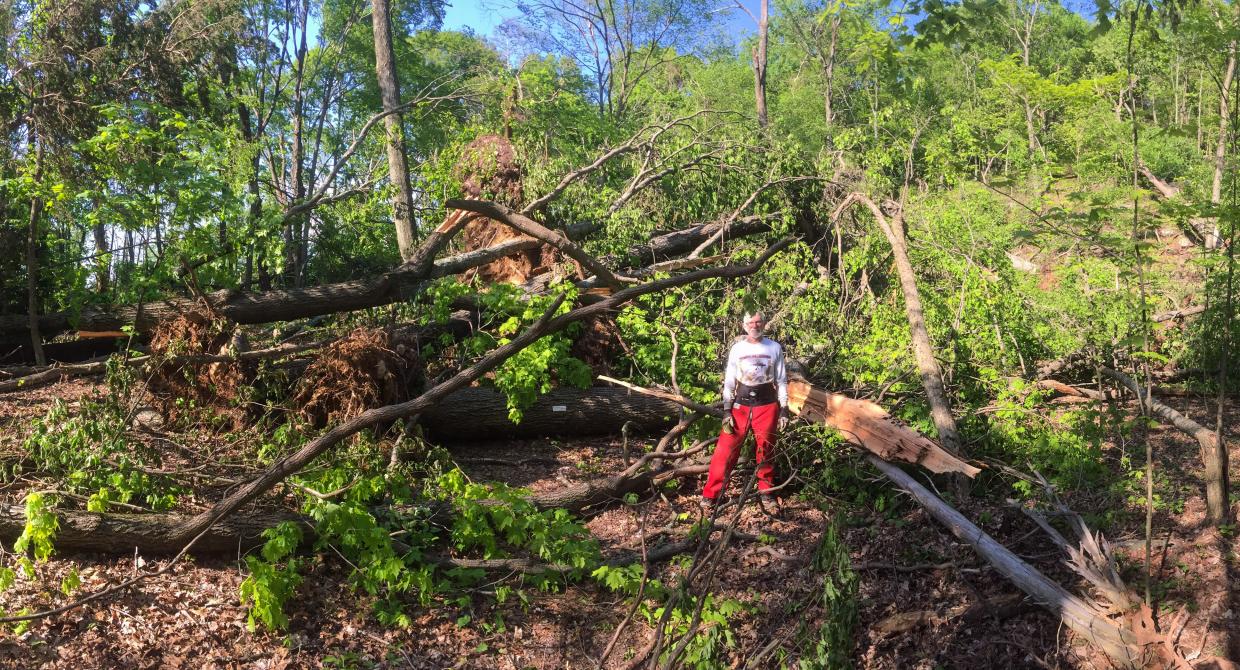After the Storm: Volunteers Tackle 'BA Hot Mess Blowdowns'
Title

Body
The Trail Tramps Crew is working hard to clear and repair trails temporarily closed or damaged by several remarkably strong storms that hit our parks this spring.
On May 21, Trail Tramps Crew member Dave Margulis and I determined that approximately a half-mile of the Sugarloaf Trail in the Castle Rock Unique Area of the Hudson Highlands was essentially impassable. On May 28, B sawyers Andrew Seirup, Walt Daniels, Fred Stern, and Bryan Blackburn were joined by A sawyer Paul Bisset to assess the damage. Trail Tramps Dave Margulis, Connie Stern, Marilyn Blaho, and Martha Rabson joined Pat Bisset and Bruce Lucas as swampers. I led, literally, since it was up to me to actually find the trail. (I hate to admit that I actually lost it in one spot and we ended up clearing one tree from a private road.)
Bryan and I started at 7:30 a.m. and were joined by the rest of the crew at 9 a.m. Five crew, includng two sawyers, finished the clearance at 4 p.m. Just as the five of us were tackling the final section of blowdowns, a pair of hikers caught up with us. I advised them that they could not pass and pointed to their goal, Sugarloaf, dead uphill to the south. They opted to bushwhack (against advice) after commenting, “the thunderstorm did this?” We had just finished clearing the trail when they returned, grateful they did not have to retrace their off-trail route up.
The penultimate mess removed from the trail consisted of more than five intertwined trees, ranging in size from about 8 inches to 20 inches, including one massive root ball. This is how we classify our blowdowns:
- Hot Mess Blowdowns: essentially the crowns of trees, resulting in long sections of trail being completely blocked by numerous, fully leafed branches.
- BA Blowdowns: (“BA” subject to interpretation): large tree trunks across or— worst-case scenario, running the length of—the trail.
- BA Hot Mess Blowdowns: combination of the first two.
The Damage
Sawyer Bryan Blackburn kept a tally of the blowdown he and his fellow volunteers tackled on the Sugarloaf Trail in just one day, from 9 a.m. to 5 p.m.:
- 24” Tulip
- 24” Red Oak
- 18” Tulip
- 24” Tulip
- 10” Maple
- 12” Red Oak
- 12” Dead Hemlock
- 20” Red Oak
- 16” Red Oak
- 16” Red Oak
- 2 x 6” dead Red Oak
- Top of 12” Red Oak
- Tops of multiple, including 16” Red Oak
- Twin 12” Red Oak
- Preparations for the 24” White Oak
WHAT WE KNOW:
- The Sugarloaf Trail and many sections of the Appalachian Trail are now cleared.
- Work is ongoing.
- The sides of trails are covered with removed debris.
- Sugarloaf now has spectacular views which did not exist prior to the “thunderstorm.”
WHAT WE DON’T KNOW:
- What will replace destroyed mature forest sections, especially in the short term.
- The future effect of extensive debris on trail drainage and structure.
- How many more crews and maintainers will be needed to deal with the damage resulting from these increasingly common severe storms. Many of our maintainers and crews were still dealing with March storm damage when this thunderstorm hit.
- There are still trails which have not been surveyed for damage. If you encounter severe damage while hiking, please report it at nynjtc.org/contact-us.
WHAT WE ARE PROFOUNDLY GRATEFUL FOR:
- Willing and able crew members, especially sawyers, who have been out every day. I am especially thankful that sawyer certifications beat the storm, enabling newly B-certified sawyers to go out with only one or two swampers.
Sawyer/Swamper Primer
The Trail Conference trains select volunteers in the safe and responsible removal of blowdown requiring chainsaws in accordance with the United States Forest Service Saw Policy. When you hear our volunteers talking about their sawyer certification level or swampers, here’s what they mean:
A-Level Sawyer: An apprentice sawyer who can saw only under the immediate supervision of a B-level sawyer.
B-Level Sawyer: An intermediate sawyer who may independently saw (with the assistance of a swamper) in moderately complex situations.
Swamper: A worker who assists sawyers by clearing away cut tree sections and clears brush, limbs, and small trees. A swamper remains alert for dangerous situations and may also carry supplies.
When trails are threatened, the Trail Conference responds.
Across the region, volunteers have been making heroic efforts in a remarkably short amount of time to clear and restore trails damaged by these spring storms. We’ve gathered on-the-ground reports from Trail Conference volunteers who have been selflessly giving days at a time to clear blowdown and make sure affected trails are once again passable and safe. It’s just one more incredible way our Trail Family works hard to make connecting with nature possible for all who seek to get outside and explore. Here are their stories:
